New archaeological paper (behind paywall) New evidence on the southeast Baltic Late Bronze Age agrarian intensification and the earliest AMS dates of Lens culinaris and Vicia faba, by Minkevičius et al. Vegetation History and Archaeobotany (2019).
Interesting excerpts (emphasis mine):
Arrival of farming in the south-east Baltic
The current state of research reveals no firm evidence of crop cultivation in the region before the LBA (Piličiauskas et al. 2017b; Grikpėdis and Motuzaitė-Matuzevičiūtė 2018). Current archaeobotanical data firmly suggest the adoption of farming during the EBA to LBA transition. (…) By comparison, in other parts of N Europe subsistence economy of CWC groups was characterized by strong emphasis on animal husbandry, however crop cultivation was also used (Kirleis 2019; Vanhanen et al. 2019). CWC sites from the Netherlands, Denmark, Sweden and Germany reveal evidence of the cultivation of H. vulgare var. nudum, T. dicoccum, Linum usitatissimum (flax) (Oudemans and Kubiak-Martens 2014; Beckerman 2015; Kubiak- Martens et al. 2015).
It is (…) striking that earliest evidence of farming in the SE Baltic only appears in the deposits dating over 4,000 years later.
The environmental conditions of the SE Baltic presented a significant barrier and numerous genetic adaptations were required before farming could successfully spread into the region (Motuzaitė-Matuzevičiūtė 2018). Adaptations through seasonality changes usually play a major role in adapting to new environments (Sherratt 1980). These include establishing genetic controls on seasonality, especially flowering times and length of growing season (Fuller and Lucas 2017). Therefore, it could be argued that farming was only firmly established in the region around the LBA after several crop species, primarily barley, became adapted to the local environment and the risk of crop failure was reduced (Motuzaitė-Matuzevičiūtė 2018). The transition to farming was further aided by the climate warming which started around 750 cal bc (Gaigalas 2004; Sillasoo et al. 2009). In such a case the fragmented evidence from earlier periods is a likely illustration of the early attempts that have failed.
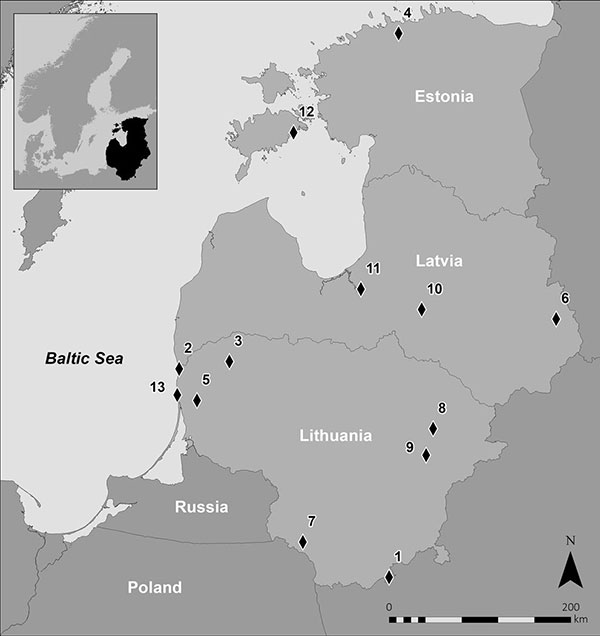
Social change
The LBA agrarian intensification of the SE Baltic was most likely not an isolated case but rather a part of broader social, economic and technological developments sweeping across northern Europe.
Evidence from sites across the Baltic Sea shows that the end of the EBA (ca. 1200 bc onward, after Gustafsson 1998) was marked by intensification of agriculture and changes in landscape management. This coincides with the agricultural developments observed on the SE fringes of the Baltic Sea and provides a context for the eventual arrival of farming, followed shortly by the rapid agrarian intensification of the region. Looking just south from the study region, we see that data from northern Poland reveal a sharp increase in both scale and intensity of agricultural activities during the EBA to LBA transition. Pollen records show significant environmental changes starting around 1400/1300 bc (Wacnik 2005, 2009; Wacnik et al. 2012). These were mostly a result of development of a production economy based on plant cultivation and animal raising. Even more significant changes during this period are visible in southern Scandinavia. Pollen records from S Sweden present evidence for an opening up of the forested landscape and the creation of extensive grasslands (Berglund 1991; Gustafsson 1998). Major changes are also apparent in archaeobotanical assemblages.
In general, during the end of the EBA northern Europe underwent a massive transformation of the farming system moving towards a more intensified agriculture aimed at surplus production. However, this should not be regarded as an isolated occurrence, but rather as a radical change of the whole society which took place throughout Europe (Gustafsson 1998). Intensification of contacts across northern Europe have integrated previously isolated regions into a wider network (Kristiansen and Larsson 2005; Wehlin 2013; Earle et al. 2015). It is therefore likely that farming spread into the SE fringes of the Baltic Sea alongside other innovations including malleable technologies and developments of social structure.
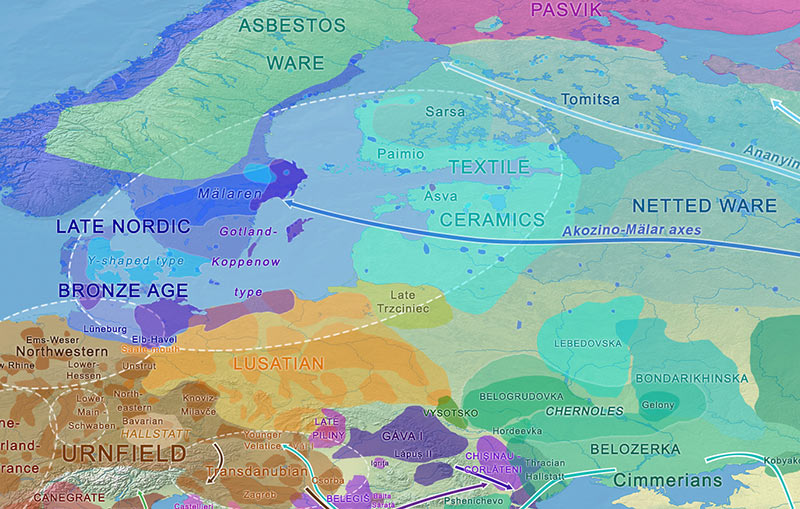
The presence and scale of intensifying connections is well illustrated by SE Baltic archaeological material.
Firstly, the appearance of stone ship graves has served as a basis for locating the Nordic communication zones. Construction of such graves was limited to the coastal regions of Kurzeme, Saaremaa Island and the Northern Estonian coast near Tallinn and Kaliningrad (Graudonis 1967; Okulicz 1976; Lang 2007) and is generally regarded as a foreign burial custom which was common in Gotland and along the Scandinavian coast. This is also supported by the Staldzene and Tehumardi hoards (Vasks and Vijups 2004; Sperling 2013), which contained artefacts typical of Nordic culture.
Secondly, studies of early metallurgy and its products, both imported and created in the SE Baltic, have concluded that metal consumption in the LBA had more than doubled compared to the EBA (Sidrys and Luchtanas 1999). The SE Baltic region lacks any metal artefact types exclusive to the region and metal objects are dominated by artefact types originating from Nordic and Lusatian cultures (Sidrys and Luchtanas 1999; Lang 2007; Čivilytė 2014). This indicates that even after metal crafting reached the region, the technology remained exclusively of foreign origin. Rarely identifiable negatives of clay casting moulds were also made for artefacts of Nordic influence, such as Mälar type axes or Härnevi type pins (Čivilytė 2014; Sperling 2014).
Lastly, emerging social diversification was accompanied by the establishment of the first identifiable settlement pattern. Settlement locations were strategically chosen alongside economically significant routes, primarily on the coast and near the Daugava River. Hilltop areas were prioritized over the lowlands, and excavations on these sites have often revealed several stages of enclosure construction (Graudonis 1989). This has also been explained as a reflection of intensifying communication networks between Nordic and Lusatian cultures, and the indigenous communities of the SE Baltic.
Proto-Balto-Slavic
One of the aspects of my description of Balto-Slavic I am least convinced about is my acceptance of Kortlandt’s dialectal classification into Proto-East Baltic, Proto-West Baltic, and Proto-Slavic, due to its strong reliance on his own controversial theory of late laryngeal loss.
Kortlandt’s position regarding Balto-Slavic is that it is in fact simply ‘Proto-Baltic’, a language that would stem thus from an Indo-Baltic branch, which would be originally represented by Corded Ware, and which would have split suddenly in its three dialects without any common development between branches, including some intermediate hypothetic “Centum” Temematic substrate that would explain everything his model can’t…
As more genetic and archaeological data on northern Europe appears, his ideas about Balto-Slavic are becoming even less credible, fully at odds with his predicted population and cultural movements, in particular because of the evident shaping of Indo-European-speaking Europe through the expansion of the Bell Beaker culture from the Yamnaya of the Carpathian Basin, and of the shaping of Uralic-speaking Europe through the expansion of the Corded Ware culture.

The site of Turlojiškė in southern Lithuania (ca. 908-485 BC) – which Mittnik et al. (2018) classified as “Bronze Age, Trzciniec culture?” – can be more reasonably considered a settlement of incoming intensive agrarian communities under the influence of the Lusatian culture, like the Narkūnai hilltop settlement in eastern Lithuania (ca. 800–550 BC), or the enclosed hilltop settlement of Kukuliškiai in western Lithuania (ca. 887-506 BC), just 300 m east of the Baltic Sea, also referred to in the paper.
While the dates of sampled individuals include a huge span (ca. 2100-600 BC), those with confirmed radiocarbon dates are more precisely dated to the LBA-EIA transition. More specifically, the first clearly western influence is seen in the early outlier Turlojiškė1932 (ca. 1230-920 BC), while later samples and samples from Kivutkalns, in Latvia, show major genetic continuity with indigenous populations, compatible with the new chiefdom-based systems of the Baltic and the known lack of massive migrations to the region.
Contacts with western groups of the Nordic Bronze Age and Lusatian cultures intensified – based on existing archaeological and archaeobotanical evidence – in the LBA, especially from ca. 1100/1000 BC on, and Baltic languages seem to have thus little to do with the disappearing Trzciniec culture, and more with the incoming Lusatian influence.
Both facts – more simple dialectalization scheme, and more recent Indo-European expansion to the east – support the spread of Proto-Baltic into the south-east Baltic area precisely around this time, and is also compatible with an internal separation from Proto-Slavic during the expansion of the Lusatian culture.
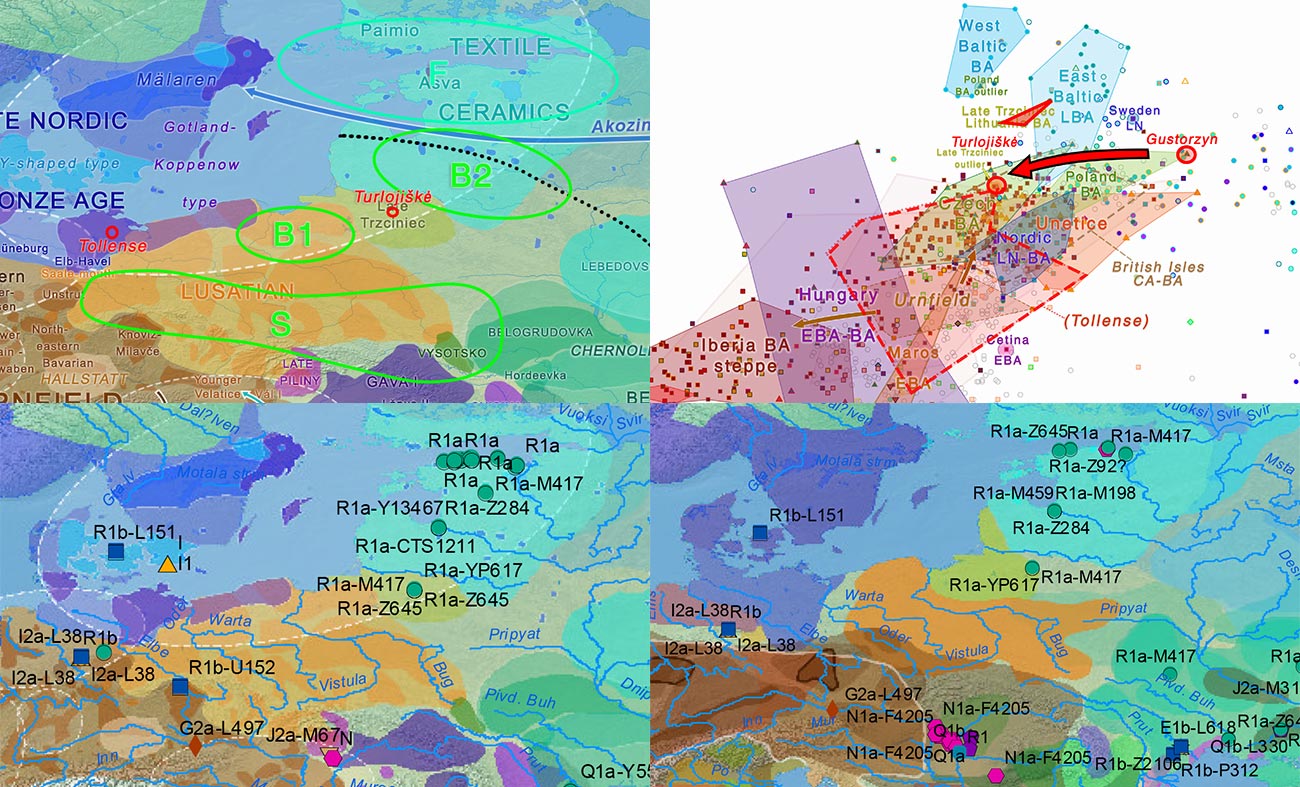
Even though comparative grammar is traditionally known to be wary of resorting to language contamination or language contact, the truth is that – very much like population genomics – trying to draw a ‘pure’ phylogenetic tree for Balto-Slavic has never worked very well, and the most likely culprit is the Slavic expansion to the south-east into territories which underwent different and complex genetic and linguistic influences for centuries (see here and here).
The close interaction of Nordic BA and Lusatian cultures (and their cultural predominance over) indigenous eastern Baltic peoples from ca. 1100 BC fits (part of) the known intense lexical borrowings of Balto-Finnic from Palaeo-Germanic and from early Proto-Baltic, as well as (part of) the known Germanic–Balto-Slavic contacts, whereas the evident Balto-Finnic-like substrate of Balto-Slavic, and especially of Baltic, must stem from the acculturation of those indigenous East Baltic peoples.
The relative chronology of hydrotoponymy in the East Baltic shows that essentially all ancestral layers to the north of the Daugava must have been Uralic, while roughly south of the Daugava they seem to be mostly Indo-European. The question remains, though, when did this Indo-European layer start?
Despite the many centuries that could separate the attestation of southern place- and river-names from northern ones, Old European is also defined by linguistic traits, which would imply that the same language inferred from Western and Southern European hydrotoponymy is that found in the Baltic, hence all from North-West Indo-European-speaking Bell Beakers and derived Early European Bronze Age groups.
Interestingly, though, it is well known that some modern Baltic toponyms can’t be easily distinguished from the Old European layers – unlike those of Iberia or the British Isles, which show some attested language change in the proto-historical and historical period – which may imply both (a) continuity of Baltic languages since the EBA, but also that (b) the Baltic naming system is a confounding factor in assessing the ancestral expansion of Old European. The latter is becoming more and more likely with each new linguistic, archaeological, and genetic paper.
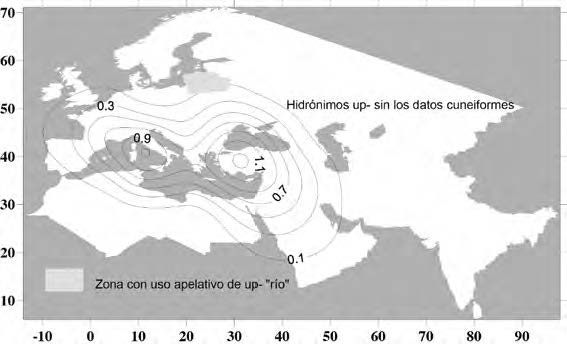
In summary, a survival of a hypothetical late Trzciniec language in Lithuania or as part of the expanding Lusatian community is not the most economic explanation for what is seen in genetics and archaeology. On the other hand, the cluster formed by the Tollense samples (a site corresponding to the Nordic Bronze Age), the Turlojiškė outlier, and the early Slavs from Bohemia all depict an eastward expansion of Balto-Slavic languages from Central Europe, at the same time as Celtic expanded to the west with the Urnfield culture.
NOTE. Another, more complicated question, though, is if this expanding Proto-Baltic language accompanying agriculture represents the extinct
early Proto-Baltic dialect from which Balto-Finnic borrowed words, hence Proto-Baltic proper expanded later, or if this early Baltic branch could have been part of the Trzciniec expansion. Again, the answer in archaeological and genetic terms seems to be the former. For a more detailed discussion of this and more, see European hydrotoponymy (IV): tug of war between Balto-Slavic and West Uralic.
As I said recently, the slight increase in Corded Ware-like ancestry among Iron Age Estonians, if it were statistically relevant and representative of an incoming population – and not just the product of “usual” admixture with immediate neighbours – need not be from south-eastern Corded Ware groups, because the Akozino-Malär cultural exchange seems to have happened as an interaction in both directions, and not just as an eastward migration imagined by Carpelan and Parpola.
Archaeology and genetics could actually suggest then (at least in part) an admixture with displaced indigenous West Uralic-speaking peoples from the south-west, to the south of the Daugava River, at the same time as the Indo-European – Uralic language frontier must have shifted to its traditional location, precisely during the LBA / EIA transition around 1000 BC.
NOTE. For more on this, see the supplementary materials of Saag et al. (2019).
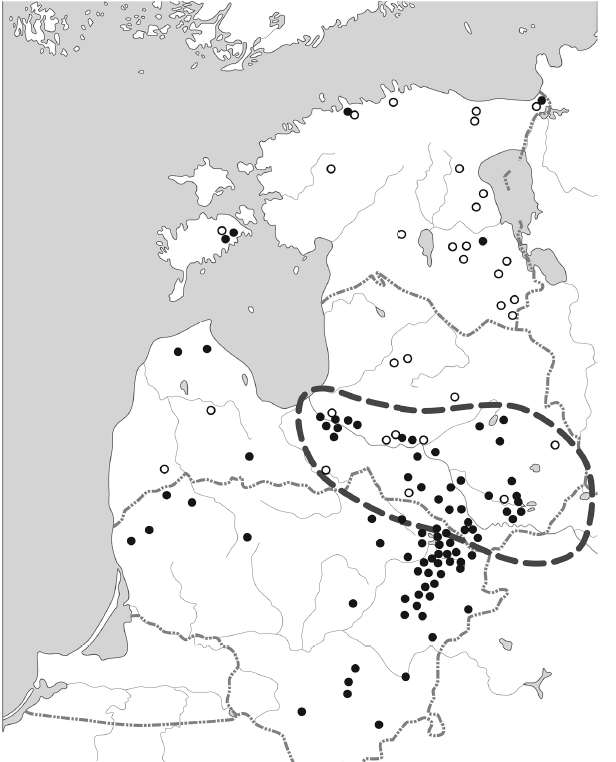
The tight relationship of the three communities also accounts for the homogeneous distribution of expanding haplogroup N1c-VL29 (possibly associated with Akozino warrior-traders) in the whole Baltic Sea area, such as those appearing in the Estonian Iron Age samples, which have no clearly defined route(s) of expansion.
It is even possible that they emerged first in the south, linked to marriage alliances of Akozino chieftains with Baltic- and Germanic-speaking chiefdoms around the Baltic Sea (see N1c in Germanic Iron Age), because the expansion of (some) N1c lineages with Gulf of Finland Finnic to the north was more clearly associated with their known bottleneck ca. 2,000 years ago.
Related
- Corded Ware ancestry in North Eurasia and the Uralic expansion
- European hydrotoponymy (IV): tug of war between Balto-Slavic and West Uralic
- Balto-Slavic accentual mobility: an innovation in contact with Balto-Finnic
- Aquitanians and Iberians of haplogroup R1b are exactly like Indo-Iranians and Balto-Slavs of haplogroup R1a
- Common Slavs from the Lower Danube, expanding with haplogroup E1b-V13?
- “Dinaric I2a” and the expansion of Common Slavs from East-Central Europe
- The cradle of Russians, an obvious Finno-Volgaic genetic hotspot
- Genetic continuity among Uralic-speaking cultures in north-eastern Europe
- Uralic speakers formed clines of Corded Ware ancestry with WHG:ANE populations
- Volosovo hunter-gatherers started to disappear earlier than previously believed
- Vikings, Vikings, Vikings! “eastern” ancestry in the whole Baltic Iron Age
- Consequences of O&M 2018 (III): The Balto-Slavic conundrum in Linguistics, Archaeology, and Genetics
- Pre-Germanic and Pre-Balto-Finnic shared vocabulary from Pitted Ware seal hunters
- Kortlandt: West Indo-Europeans along the Danube, Germanic and Balto-Slavic share a Corded Ware substrate
- Pre-Germanic born out of a Proto-Finnic substrate in Scandinavia
- On Proto-Finnic language guesstimates, and its western homeland
- On the origin and spread of haplogroup R1a-Z645 from eastern Europe